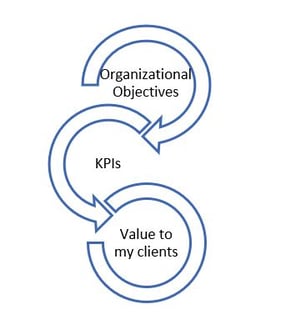Use Case: Apply DMAIC in the Finance Industry
As in the retail or manufacturing industry, the financial sector does not escape having a high volume of daily transactions. Each transaction is data...
Achieving success in our organization, being more efficient, actively listening to our customers, and being ahead of the competition are some of the orders we want to achieve successfully. Every business runs after attaining these objectives, but how do you reach them without getting lost along the way? What are we doing well, and what can we improve? Do we have information, data, and evidence that show us an accurate picture of our organizations? The answers lie in the Key Performance Indicators (KPI).
Find out how to establish key indicators and where to focus your efforts in this blog. Especially if you are managing an organization or are part of the strategic management and are looking for greater profitability.
Index
What is a Key Performance Indicator?
The indicators or KPI is the information that allows us to measure the progress of a process. In other words, it is to place a thermometer that gives us a measurement of how the temperature is: cold, warm, hot. For our organization, it is to determine if our business processes are below a goal, if they are close to the objectives or if they exceed expectations. A proper definition of the indicators will be essential for the evolution and maturity of the processes. Leading us in a comprehensive and orderly manner to meet the agreed goals.
For example, we want to measure a purchase process through a website. It can be proposed as an indicator to count the number of visits to this website. Still, as a key indicator, you must establish how many of these visits result in effective purchases for your business.
Among the characteristics that the indicators must have, we can mention the following:

Figure 1: Summary of indicator characteristics
We may find ourselves in the following dilemma: what type of indicators are required by my organization? This will depend on the type of industry and other variants. For example, beyond finding a recipe and its ingredients (in this case, a list of indicators), we must be aware that these go in the direction that marks my compass: the company's objectives.
It will be possible to propose various interesting indicators, but you must be very clear about the objectives you have to meet. If this will benefit the customers and if the process is mature enough to apply this indicator.
Below is an image of the sequence that triggers a good definition of the organization's objectives in addition to the measurement of the processes to fulfill the customers' expectations.

Figure 2: Aspects that trigger added value to the clients.
Read more: 10 Signs that it is time to update your business model
Additionally, I list some indicators as a reference that are widely used and will allow you to go after the purpose you are looking for:
Advantages of a results-oriented organization
Part of the exercises and methodologies we must have on our radar is to motivate the culture of measurement that helps to improve, innovate, and, therefore, be steps ahead of the competition. So we should not be reluctant to the measurements and the results generated. On the contrary, if we do not measure, we will not know if we do well or if we should improve, where we can change and how we can manage the resources efficiently.
If you are still not sure if the key indicators can help organizations, I will point out the advantages here:
Maybe you might be interested in: 11 sales productivity indicators you should know
How do you define key indicators?
Once we have clear objectives and they are duly communicated to the organization, we have the following points on how to define indicators for the processes step by step:
Learn about tools that could help you: HubSpot forecast software: The crucial indicator for management
At Imagineer, we are willing to help you and provide you with a customized consulting service to answer all your questions regarding indicators or how to apply these steps to your organization's specific processes. Visit our website, www.imagineer.co
Throughout this blog, we contemplated the key business indicators and that a reasonable determination of them will allow you to be more efficient and agile and move loosely towards change. Many organizations are successful, but not by chance. They are aligned to a structure, processes, and how to measure them.; this allows the various areas to have autonomy. We must establish key business indicators, which will be our allies and a valuable tool for the organization's growth.

As in the retail or manufacturing industry, the financial sector does not escape having a high volume of daily transactions. Each transaction is data...

When we are part of an organization, we find different areas, which will be composed of teams and systems that perform various tasks. This synergy...

Companies are usually structured by function, which is not a bad thing at all. Still, if you don't have process management, it will be harder to...